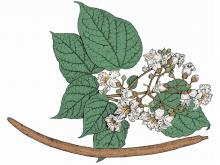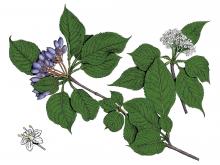Trees, Shrubs and Woody Vines
Media

Species Types
Scientific Name
Fraxinus pennsylvanica
Description
Green ash is one of the most widely planted shade trees around homes and along streets. In the wild, it lives along streams and in low grounds. Sadly, it is one of the trees most vulnerable to the emerald ash borer, an exotic invasive pest.
Media

Species Types
Scientific Name
Fraxinus americana
Description
White ash leaves turn shades of yellow and purple in fall, and that is one reason it has been a popular landscaping tree. Many birds and mammals feed on the paddle-shaped seeds.
Media

Species Types
Scientific Name
Acer rubrum
Description
Red maple is one of our most useful — and beautiful — native trees. You can find it in the woods as well as in landscape plantings statewide. Many horticultural varieties are available at nurseries.
Media

Species Types
Scientific Name
Acer saccharinum
Description
In nature, silver maple is a bottomland tree. Silver maples pay for their rapid growth by having rather brittle branches that easily break off in windy and other inclement weather.
Media

Species Types
Scientific Name
Acer negundo
Description
A member of the maple family, box elder is often confused with poison ivy because its compound leaves sometimes grow in threes (though also in fives). A fast-growing tree, its winged seeds betray its relationship to other maples.
Media

Species Types
Scientific Name
Salix spp. (about 12 species in Missouri)
Description
Exotic willows are available at lawn and garden centers, but there are several willow species that are native to Missouri. Most are rather humble colonizers of gravel bars, riverbanks, and lakesides. Many are important for human economic interests. All have a place in our wild ecosystems.
Media

Species Types
Scientific Name
Euonymus fortunei
Description
Introduced from Asia as a groundcover, wintercreeper has escaped cultivation in all the eastern states. It’s frequently found near urban centers, with heavy infestations in woodlands around St. Louis and Kansas City.
Media

Species Types
Scientific Name
Catalpa speciosa
Description
Of the three species of catalpas in our state, northern catalpa is the only one native to Missouri (specifically, the Bootheel region). It has been planted widely, though, and has naturalized in many places. A popular ornamental and shade tree with pretty, orchidlike flowers and long, beanlike fruit.
Media

Species Types
Scientific Name
Staphylea trifolia
Description
American bladdernut is a thicket-forming shrub or small tree that grows in moist soils. It produces clusters of bell-shaped white flowers in spring and unusual 3-parted air-filled capsules in late summer that turn papery and persist into winter.
Media

Species Types
Scientific Name
Viburnum lentago
Description
Nannyberry is an understory shrub or small tree that grows in low woods, wooded slopes, and rich valleys near streams. It is officially a Species of Conservation Concern in our state, but its rarity here may be because Missouri is at the southern end of its range.
See Also
About Trees, Shrubs and Woody Vines in Missouri
There are no sharp dividing lines between trees, shrubs, and woody vines, or even between woody and nonwoody plants. “Wood” is a type of tissue made of cellulose and lignin that many plants develop as they mature — whether they are “woody” or not. Trees are woody plants over 13 feet tall with a single trunk. Shrubs are less than 13 feet tall, with multiple stems. Vines require support or else sprawl over the ground.





















